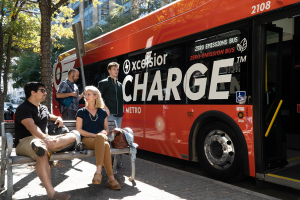 The U.S. is still struggling to contain the spread of COVID-19 and quantify the human and economic consequences of this historic tragedy. But already, leaders are contemplating how we’ll restore our economies. Will we rebuild a replica of what we had, or will we invest in ideas that will make society more resilient, healthier, cleaner and more equitable?
The U.S. is still struggling to contain the spread of COVID-19 and quantify the human and economic consequences of this historic tragedy. But already, leaders are contemplating how we’ll restore our economies. Will we rebuild a replica of what we had, or will we invest in ideas that will make society more resilient, healthier, cleaner and more equitable?
The transportation sector is on the cusp of massive change, and one segment within it is ripe for reinvention: medium- and heavy-duty vehicles. These include everything from semi-trucks and delivery vans, to city buses and garbage trucks — the overwhelming majority of which are powered by diesel engines.
Electrifying this segment was an opportunity for lasting change before the COVID-19 economic crash. Now that countries are considering where to invest to rebuild their economies, it’s an opportunity we can’t afford to miss.
Zero-emission vehicles currently comprise a negligible share of the truck market, but they possess the potential to be the workhorses of a clean energy future. They can also help reduce the toxic pollution people breathe in from diesel-emitting tailpipes. Approximately 30 to 45% of the urban population in North America lives “next to a busy road” — and children who live or go to school near major roadways are at considerable additional risk for substantial deficits in lung function, even in areas with low regional pollution.
Globally, climate emissions from large vehicles are on pace to double in the next 30 years, when we must be driving down net emissions to zero. To reverse this trend and transform large vehicles into a critical part of a 100% clean economy, the global fleet must complete a near-total transition to zero-emission trucks and buses. The U.S., China and Europe — as the largest truck markets — must lead the way to this transition by 2050.
“A Herculean task”
In its 2019 EV Outlook, Bloomberg New Energy Finance found that, by 2040, just 31% of new medium-duty trucks and just below 20% of new heavy-duty trucks will be electric in the U.S., China and Europe. At this pace of adoption, fossil-fuel-powered trucks would still account for more than half of trucks on the road in the U.S., Europe and China in 2050.
Clearly, we must put our foot on the accelerator if we are to ensure a near-total transition to electric trucks and buses by 2050.
This task is made more challenging by the decade or more lifetime of a new truck — meaning that converting the fleet by 2050 will require that nearly all new vehicles entering the fleet are zero-emission by 2040. Additionally, it takes time for a new technology to gain market share, as production scale must be built and fleet decision makers must gain confidence in the ability of the technology to perform. For example, diesel trucks first started to gain significant market share in the mid 1950’s, but did not achieve 80% market share for the heaviest trucks until 1970.
While difficult, a picture of how we might accomplish this Herculean task is beginning to emerge — articulated originally by CALSTART, a national nonprofit consortium focused on building a prosperous, efficient and clean high-tech transportation industry.
Key to this path is the recognition that the large truck market is an amalgamation of many segments. Some will be harder to electrify than others, but each will play an important role in laddering up to a near total transition of trucks and buses to zero-emission.
How we’ll get there
Nationally, by focusing first on the market segments with the strongest economic and environmental case for electrification, we can create production scale for batteries and other components, while also advancing our understanding of how to design effective charging strategies and financing programs. Large production scale will attract more research and development to further drive down component costs and improve battery quality. In turn, this will enable the continuous expansion of zero-emission solutions into more challenging market segments, like semi-trucks.
This approach will allow us to achieve the ambitious goal of a near-total transition to electric trucks and buses by 2050. As an interim target, at least 30% of the entire new truck market across the country must be zero-emission by 2030. The market would then need to maintain a 30% annual rate of growth through the 2030s — an aggressive target, but one that would mirror the rise of the diesel engine in the mid-20th century.
Some market segments can and should electrify faster than others because their maturation in the market is further along. By 2030:
- At least 80% of new transit buses should be electric.
- At least 50% of new school buses should be electric.
- At least 40% of new work trucks should be electric.
- At least 25% of new regional tractors should be electric.
These numbers are for the entire U.S. market. Some states and regions, like California, which just adopted the landmark Advanced Clean Trucks program, can and should surpass these targets given local air pollution pressures and the unique composition of the state truck fleet.
Several barriers stand in the way of widespread deployment of these vehicles, but thankfully we already have the know-how to overcome each of them. Now we need a commitment from the truck industry, utilities, policymakers and others to leverage these solutions, and the ambition to achieve market transformation. Being part of national efforts to rebuild bruised economies would not only provide a powerful boost, it would be smart policy.









